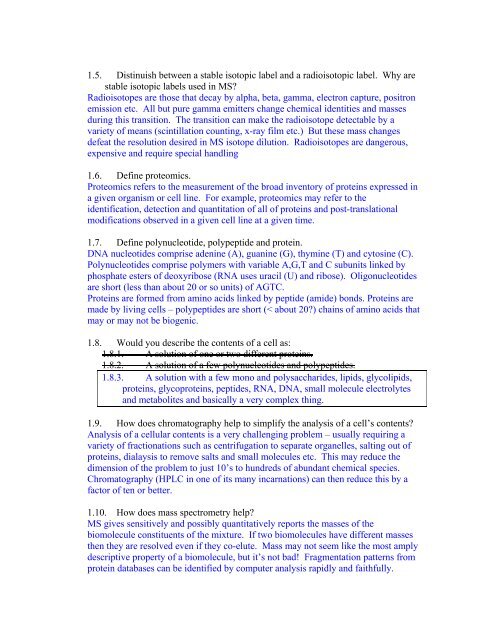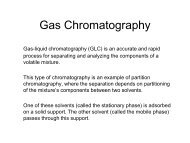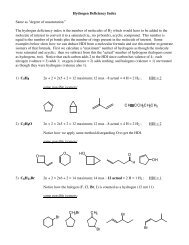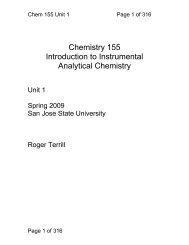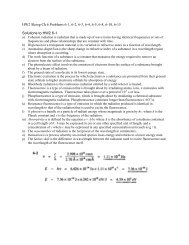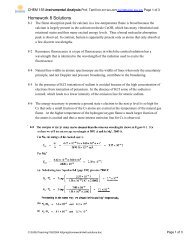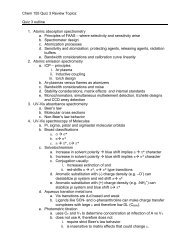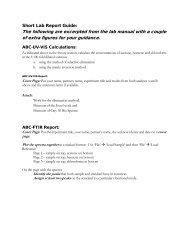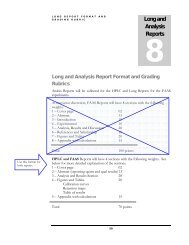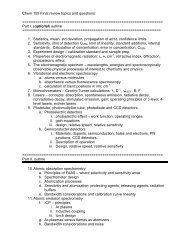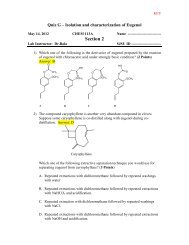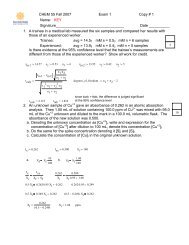Answers to HW Questions
Answers to HW Questions
Answers to HW Questions
You also want an ePaper? Increase the reach of your titles
YUMPU automatically turns print PDFs into web optimized ePapers that Google loves.
1.5. Distinuish between a stable iso<strong>to</strong>pic label and a radioiso<strong>to</strong>pic label. Why arestable iso<strong>to</strong>pic labels used in MS?Radioiso<strong>to</strong>pes are those that decay by alpha, beta, gamma, electron capture, positronemission etc. All but pure gamma emitters change chemical identities and massesduring this transition. The transition can make the radioiso<strong>to</strong>pe detectable by avariety of means (scintillation counting, x-ray film etc.) But these mass changesdefeat the resolution desired in MS iso<strong>to</strong>pe dilution. Radioiso<strong>to</strong>pes are dangerous,expensive and require special handling1.6. Define proteomics.Proteomics refers <strong>to</strong> the measurement of the broad inven<strong>to</strong>ry of proteins expressed ina given organism or cell line. For example, proteomics may refer <strong>to</strong> theidentification, detection and quantitation of all of proteins and post-translationalmodifications observed in a given cell line at a given time.1.7. Define polynucleotide, polypeptide and protein.DNA nucleotides comprise adenine (A), guanine (G), thymine (T) and cy<strong>to</strong>sine (C).Polynucleotides comprise polymers with variable A,G,T and C subunits linked byphosphate esters of deoxyribose (RNA uses uracil (U) and ribose). Oligonucleotidesare short (less than about 20 or so units) of AGTC.Proteins are formed from amino acids linked by peptide (amide) bonds. Proteins aremade by living cells – polypeptides are short (< about 20?) chains of amino acids thatmay or may not be biogenic.1.8. Would you describe the contents of a cell as:1.8.1. A solution of one or two different proteins.1.8.2. A solution of a few polynucleotides and polypeptides.1.8.3. A solution with a few mono and polysaccharides, lipids, glycolipids,proteins, glycoproteins, peptides, RNA, DNA, small molecule electrolytesand metabolites and basically a very complex thing.1.9. How does chroma<strong>to</strong>graphy help <strong>to</strong> simplify the analysis of a cell’s contents?Analysis of a cellular contents is a very challenging problem – usually requiring avariety of fractionations such as centrifugation <strong>to</strong> separate organelles, salting out ofproteins, dialaysis <strong>to</strong> remove salts and small molecules etc. This may reduce thedimension of the problem <strong>to</strong> just 10’s <strong>to</strong> hundreds of abundant chemical species.Chroma<strong>to</strong>graphy (HPLC in one of its many incarnations) can then reduce this by afac<strong>to</strong>r of ten or better.1.10. How does mass spectrometry help?MS gives sensitively and possibly quantitatively reports the masses of thebiomolecule constituents of the mixture. If two biomolecules have different massesthen they are resolved even if they co-elute. Mass may not seem like the most amplydescriptive property of a biomolecule, but it’s not bad! Fragmentation patterns fromprotein databases can be identified by computer analysis rapidly and faithfully.


